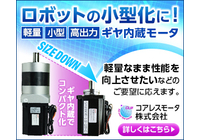Peach Boy Series [Basic Knowledge Material] #Sine Wave Driven Motor Driver
This is a technical document on sine wave drive motor drivers. It thoroughly explains the differences between rectangular wave drive drivers and sine wave drive drivers. #BasicKnowledgeDocument
Compared to conventional rectangular wave driving, this is a brushless motor driver that is overwhelmingly efficient, compact, low-vibration, and low-noise. Sine wave driving is a method of driving the motor by continuously varying the current in a sinusoidal (sine wave) manner. When viewed on an oscilloscope, the waveform is characterized by a clean sine wave, and because it approximates the induced voltage, it is more efficient compared to rectangular wave driving.
basic information
The sine wave driven brushless motor detects the rotor position and rotates the rotor by varying the voltage of the coils in a sine wave pattern according to its rotational angle, creating a rotating magnetic field. By continuously applying sine wave voltage to the coils in synchronization with the rotation, the rotor can be kept rotating continuously. Rectangular wave driving is the simplest driving method, where the ON/OFF state of the power elements is switched according to the rotor's rotational angle, changing the direction of the current in the stator coils to rotate the rotor. When the rotor completes one full rotation (360 degrees), the direction of the current is switched 6 times (every 60 degrees). This method is the same as the driving principle of brushed DC motors. The motor is driven using an inverter circuit that controls the voltage with PWM. This method is the most commonly adopted for driving sensorless motors.
Price range
Delivery Time
Model number/Brand name
Momotaro Series
Applications/Examples of results
The speed of a brushless motor is adjusted by changing the voltage. By increasing the voltage and raising the frequency of the drive command waveform, the rotation speed increases. If only the frequency of the drive command waveform is increased, the rotor will be unable to keep up with the rotation and will stop. Additionally, if only the voltage is increased, the rotor will rotate faster, but if the frequency of the drive command waveform is too slow, the rotor will also stop. Therefore, adjustments to both the voltage and the drive command waveform are necessary. (The frequency of the drive command waveform for the brushless motor is determined by the detection of the rotor's position.) (Toshiba Device & Storage Corporation https://toshiba.semicon-storage.com/jp/top.html)
Related Videos
catalog(3)
Download All CatalogsRecommended products
Distributors
Coreless motors are engaged in the development, manufacturing, and sales of precision small motors, generators, and drivers, offering a wide range of products specialized in lightweight and energy-saving technologies through proprietary technology. 【Product Lineup】 - Coreless Brushless DC Motors - Cored Brushless DC Motors (ODM) - Small Geared Motors (ODM) - General-purpose Geared Motors (some ODM) - Gear-integrated Motors (Winner of the 36th Kanagawa Prefectural Industrial Technology Development Award) - In-wheel Motors for Electric Wheelchairs - Wheel Servo Motors (ODM) - Brushless Motor Drivers (some OEM) - Battery-powered AC Servo Motors (some ODM) - AC Servo Motion Controllers (ODM) - Renewable Energy Generators (some ODM) - Wind Turbines with EAT - IC Fan Motors - Conventional Axial Flow Fan Motors (ODM) - DC Blower Fan Motors (ODM) - Linear Motors
















































